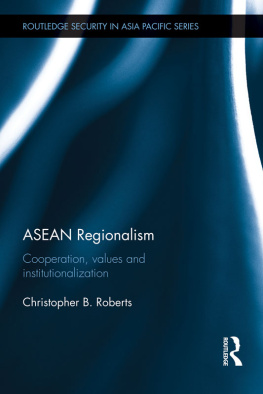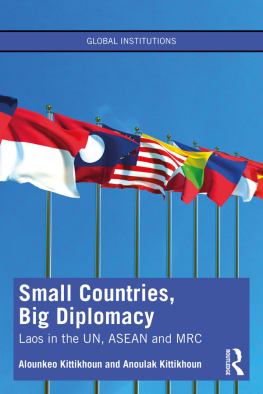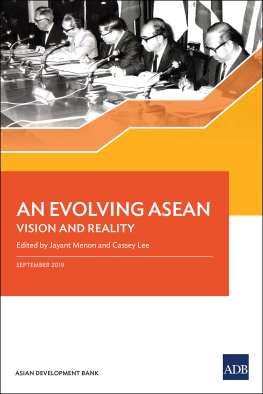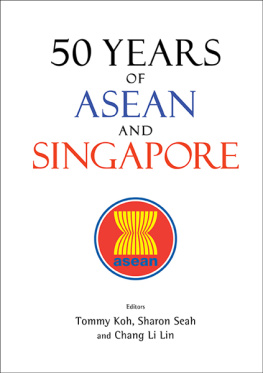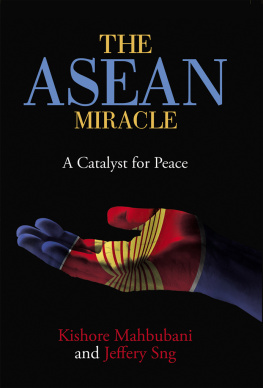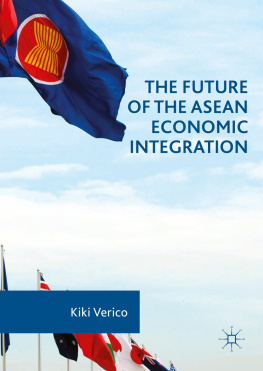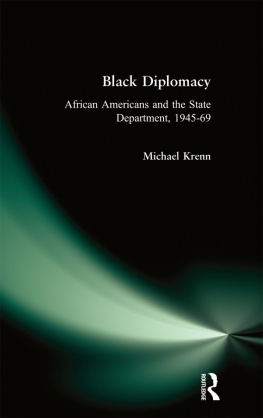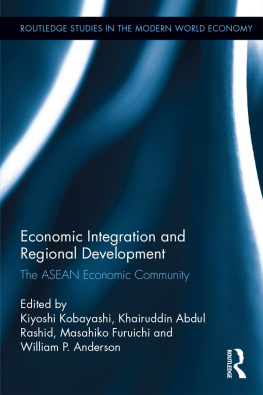ASEAN
and the Diplomacy of Accommodation
Source: U.S. Department of State.
Boundary representation is not necessarily authoritative.
ASEAN
and the Diplomacy of Accommodation
Michael Antolik
An East Gate Book
First published 1990 by M.E. Sharpe, Inc.
Published 2016 by Routledge
2 Park Square, Milton Park, Abingdon, Oxon OX14 4RN
711 Third Avenue, New York, NY 10017, USA
Routledge is an imprint of the Taylor & Francis Group, an informa business
Copyright 1990 by Taylor & Francis. All rights reserved.
No part of this book may be reprinted or reproduced or utilised in any form or by any electronic, mechanical, or other means, now known or hereafter invented, including photocopying and recording, or in any information storage or retrieval system, without permission in writing from the publishers.
Notices
No responsibility is assumed by the publisher for any injury and/or damage to persons or property as a matter of products liability, negligence or otherwise, or from any use of operation of any methods, products, instructions or ideas contained in the material herein.
Practitioners and researchers must always rely on their own experience and knowledge in evaluating and using any information, methods, compounds, or experiments described herein. In using such information or methods they should be mindful of their own safety and the safety of others, including parties for whom they have a professional responsibility.
Product or corporate names may be trademarks or registered trademarks, and are used only for identification and explanation without intent to infringe.
Library of Congress Catologing-in-Publication Data
Antolik, Michael, 1948
Asean and the diplomacy of accommodation / by Michael Antolik
p.cm.
Includes bibliographical references.
ISBN 0-87332-630-X
1. Asia, SoutheasternPolitics and government1945. 2. Asia, SoutheasternForeign relations. 3. ASEAN. I. Title.
DS526.7.A59 1990
327.0959dc20
89-49026
CIP
ISBN 13: 978-0-87332-630-8 (hbk)
To John Baptist De La Salle
Contents
THE ASEAN logo represents a rice bowl, a cultural commonality to all its members, with six vertical lines to toll the membership. When taken together, these elements remind that ASEAN stands for a grouping of individual states whose record of coordinated policy suggests commonality and solidarity. Interestingly, this logo also summons up an important question about the Association: Just as the absence of a horizontal band prompts the observer to ask what holds the bowl together, so too one asksWhat holds the ASEAN states together?
In 1984 a Malaysian diplomat offered this explanation: Asean is just a club. At first glance the description of the Association of Southeast Asian Nations (ASEAN) as a club may not appear very useful or scientifically rigorous; but consider the dictionary meanings of club : a group organized for a purpose; an organization which offers its subscribers benefits. These two dimensions, organization and securing benefits, are intrinsic dynamics of institution formation in particular and politics in general. That a member describes the institution as a club signifies the informality characteristic of ASEAN interactions, as well as the good feelings, sense of trust, and even smiles that the member diplomats are often so careful to project to outsiders. Consequently, ASEAN can be investigated along all these lines suggested by the metaphor of a club.
The ASEAN phenomenon invites investigation because it has remained effective and valued for over twenty years; other regional associations have come and gone over this time. ASEANs success invites comparison both to help it avoid pitfalls and to aid other groupings in their search for improved multilateral cooperation processes. Comparison, however, has sometimes proved to be confusing. While ASEAN stands tall compared to several defunct or paralyzed regional organizations, its stature next to the progress of the European Community is less imposing.
In particular, the recent steps announced by the EC to integrate more fully members economies contrast dramatically with the small number of ASEAN joint-economic projectson this level, ASEAN deserves the label paralyzed, if not defunct. (It was such an indictment that evoked the description of club and continued, it cant do wonders overnight.) ASEANs own articulations invite such charges, however; declarations and policy statements could easily lead one to believe that the acronym also stands for Always Stress Economics And Neutrality. In fairness, one should note that the ASEAN position has evolved from its founding days, when it appeared that governments were entering into a multilateral approach to economic cooperation, to the contemporary approach which views the Association as an enabler to private-sector economic cooperation. Nevertheless, when trying to explain the nature and functions of the Association, the ASEAN paradox often arises. Why have states maintained membership in a club that has not produced the benefits offered in its charter?
The invocation of neutrality suggests that ASEAN perhaps provides a benefit in that other area important to states, security; but this benefit is even more deeply shrouded by the mists of ASEAN. Security activity or cooperation is officially eschewed by the ASEAN organization; yet things are somewhat more flexible in reality, as much is done under the ASEAN umbrella or in the spirit of ASEAN. The role that security interests play is obfuscated by an all-too-frequent identification of ASEAN with another organization, SEATO. Though years departed, SEATO still seems to have more name-recognition than ASEAN in all circles but those familar with Asian politics. Comparing ASEAN with SEATO makes clear that ASEAN is not a formal, collective defense organization; however, ASEAN members bilateral security-related cooperation continues the confusion. This cooperation creates the impression of an alliance despite denials, explanations, or rationalizations that such activity is not an ASEAN activity, only done in the spirit of ASEAN.
So perhaps discerning this spirit is central to understanding what holds this association together. Indeed, ASEAN has many characteristics of a spiritone is never sure when it is present, but its presence is often felt and influences decisions. Many gatherings are held and individual sacrifices are made in its name. Many claim to know its will and speak accordingly. Most telling, ASEAN is hard to define.
To illustrate, a first challenge concerns the style of the acronym; should it be ASEAN or Asean? Though the practice in Southeast Asia favors the latter and many style books advocate lower case for acronyms of more than four letters, I have chosen ASEAN because the Association is not widely recognized outside its home region, and Asean is often taken for a typing error for Asian.






